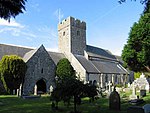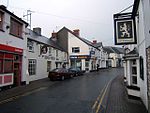St Donat's Castle (Welsh: Castell Sain Dunwyd), St Donats, Wales, is a medieval castle in the Vale of Glamorgan, about 16 miles (26 km) to the west of Cardiff, and about 1+1⁄2 miles (2.4 km) to the west of Llantwit Major. Positioned on cliffs overlooking the Bristol Channel, the site has been occupied since the Iron Age, and was by tradition the home of the Celtic chieftain Caradog. The present castle's origins date from the 12th century when the de Haweys and later Peter de Stradling began its development. The Stradlings held the castle for four hundred years, until the death of Sir Thomas Stradling in a duel in 1738.
During the 18th century, the castle's status and condition declined and by the early 19th century it was only partly habitable. The later 19th and early 20th centuries saw several restorations. In 1852, it was purchased by John Whitlock Nicholl Carne, who claimed descent from the Stradlings but whose efforts at reconstruction were not well regarded. More enlightened improvements were made by its subsequent owner, the coal magnate Morgan Stuart Williams.
The castle's transformation occurred after its purchase in 1925 by William Randolph Hearst, the American newspaper tycoon. Hearst undertook a "brutal" expansion, including the incorporation of elements from other ancient structures such as the roofs of Bradenstoke Priory in Wiltshire and St Botolph's Church in Lincolnshire. His approach to architectural reclamation was controversial and the destruction of Bradenstoke was opposed in a vigorous campaign organised by the Society for the Protection of Ancient Buildings. Bernard Shaw described the castle after Hearst's reconstruction as "what God would have built if he had had the money". Despite spending vast sums of money on St Donat's, Hearst rarely visited and in 1937, with the Hearst Corporation facing financial collapse, the castle was put up for sale, but with war looming, the castle was instead requisitioned for use by the army.
In 1960, some nine years after Hearst's death, it was purchased by the son of the businessman and educational philanthropist Antonin Besse and donated to the trustees of Atlantic College, the first of the United World Colleges. Today the castle is home to some 350 international students and, with a history of occupation extending back to the late 13th century, is among the oldest continuously inhabited castles in Wales. Both the castle and the grounds are of historical and architectural importance, and have Grade I listed status.









